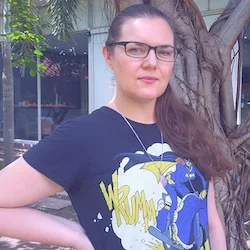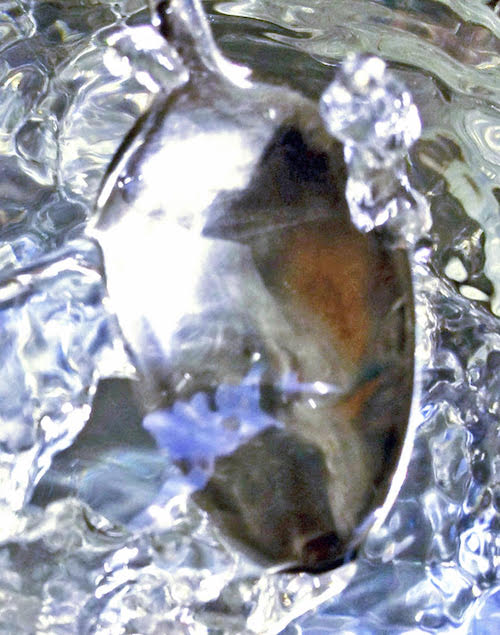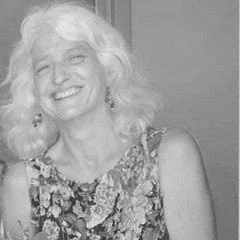Texas Sky
Fatima Al Matar
Did I tell you how beautiful the sky is in Texas?
On some mornings, it’s an endless field of powder blue with strokes of soft pearl.
Some days the sky resembles Monet’s waterlily ponds, lavender melting into dusty pink, clouds like tufts of cotton.
Sunsets are the most magical, violent blood-red streaks tearing open the belly of a blue evening. Dizzying in its brutality and majesty.
Even when it rains and the sky throws tantrums and tormented clouds blow across, even then there is beauty and power. The next morning, all is forgiven. The furious sky is a tranquil azure once more, with vigorous white splashes like the crests of leaping dolphins.
I stand at the chain-link fence; my fingers curl around the cold, diamond-shaped wire. On the other side of this detention center is America, the land of freedom, hope, and opportunity.
I look up. It is early January 2019; the snow geese are making their annual migration flight across the country, traveling south to warmer climates, their comical cries echoing one another. Every flock creates the letter V as they fly. V for victory, I think, as multiple Vs rush across the sky above me. A tremendous sense of freedom, knowing no boundaries, accepting no border, no country, no fence, or law.
I am overcome with emotion; this is what it’s like to be free.
My thirteen-year-old daughter and I shouldn’t be here.
We arrived at Chicago O’Hare International Airport, late December, carrying valid passports and visas. The date on our return tickets exceeded the permissible six-month stay, which raised suspicion. Our luggage was searched and the documents I had brought with me proving my prosecution in my homeland Kuwait were found—translated papers detailing my persecution for my political and religious views and my social activism.
“If you don’t tell me why you’re really here, I will put you on the next plane to Kuwait,” the angry officer bellowed. Inside the interrogation room of The Department of Homeland Security, under the jeering gaze of five other armed cops, I explained that I had come to America seeking asylum.
I lie awake on the bottom bunk bed in the detention center in Texas; my daughter occupies the top. We share this room with five other families—mothers and their children. We’re the only English-speaking family here. I listen to the rapid Spanish chatter between our roommates. I don’t understand a word, and yet, the emotion of the language moves me: the rise and fall of the quick string of words, laughter that soon turns to something resembling a serious reprimand, then a burst of hysterical laughter once more. Up and down, the emotions go within seconds, always a sense of urgency and drama. The breathlessness of the language is engaging. They’ve turned the television to a radio channel playing Spanish songs—loud, fast, catchy, upbeat, multi-instrumental songs that urge one to dance. It is past ten o’clock at night, and I wonder if Jori, my daughter, can sleep through this noise. I contemplate whether to shout over the noise and ask her if she’s okay, or climb up to her bed to check on her. I do neither. I feel lethargic and out of touch, unable to comprehend my reality, thinking of all the borders I came to for safety but wasn’t allowed to cross.
What will happen to us? Returning to Kuwait is not an option; we’ve left that life behind, that door has closed.
I remember the tremendous fear I felt while we were detained for three long days in the airport, in a two-by-two meter room, with nothing but two dirty mattresses covering the whole floor, three security cameras on the ceiling monitoring us from different angles, and glaring, eye-watering fluorescent lights we weren’t allowed to turn off. They took our cell phones and our luggage. Whenever I asked how long we would be kept there, I was told that due to a government shutdown and the upcoming New Year holiday, it would take days.
“But don’t think you’ll be moved to a better place when you leave here, you’ll only be put in another cell,” the guards sneered.
With lights constantly on and no watch on my wrist, time stretched endlessly, an uninterrupted scream. I had no way of telling how much time had passed, lost in an unfamiliar limbo between night and day, between today, yesterday, and tomorrow.
I laid a shawl I was wearing under Jori’s head before she fell asleep, so her face wouldn’t come into contact with the dirty gym mattress, and felt a mammoth sense of guilt. What had I done? Why did I think it was safe for me to come to America and put my child through this?
Full of shame and regret I sat there and watched my daughter sleep, afraid to sleep myself, worried something would happen to her. Afraid to ask if I could use the restrooms for the same reason. Would we be safe? What would happen to us? Would they separate us at the detention center? I smothered my tears, not wanting Jori to wake up and see me crying; I needed to stay strong for her.
From another room nearby, a woman with a Latin-American accent was screaming with anguish: “Let go of me, don’t touch me, I didn’t do anything wrong,” followed by the sounds of male and female guards asking her to calm down. Another woman, with an Arabic accent and three small children, was crying and explaining to an officer in broken English why it was impossible for her to return to Saudi Arabia.
The details of when they flew us from Chicago to San Antonio, Texas, where the detention center is located is a blur. There was a lot of shouting. “Get up! They’re taking you to a detention center,” “Quick, you’ll miss the plane,” “No, you can’t take your cat, no pets are allowed in the detention center, and if no one comes to claim it, we’ll take it to a shelter,” the guards barked. There were a lot of tears when we had to say goodbye to our cat Ty, whom we had brought with us because he’s family. “Open your bags and dump as much stuff as possible, the bags are too heavy, we don’t want to pay for the extra weight. Besides, ICE won’t let you keep all this stuff,” the guards yelled at us and we silently obeyed, throwing away our personal belongings.
When I think of how unfree I was for most of my life, the reality of my lack of freedom chokes me. I was constantly monitored and criticized as a girl in my family home by my strict parents; abusive, harsh, and unforgiving, they enjoyed reminding me that there are limits for a girl in conservative Kuwaiti culture. Home was never a safe space for me to express myself freely.
Then my arranged, and ill-matched, marriage to a man I couldn’t love, and worse, couldn’t befriend. And learning that there’s a different level of loneliness, loss, and alienation to being with a man who feeds and fattens on putting me down. Throughout the four unhappy years I was married to him, there were violence, control, abuse, and judgment. Very early on I knew I had to keep my thoughts and opinions to myself. I knew that my home, when he was in it, was not a safe space for me to be who I really was.
I fled the control of my family and the control of my husband, but there was a larger prison, society.
In a cold, austere courtroom, I sat next to my lawyer, awaiting my verdict. The seriousness of the mahogany furnishings and the judge’s elevated bench added to the drama. A large plaque in the shape of a scale hung on the center wall, with a verse from the Qur’an—“And when you judge between people, judge with justice”—written underneath. The silence seemed to suck all the air out of the room. Only the gentle sound of prayer beads bumping against each other created an eerie rhythm, the way a ticking clock threatens that time is running out.
My heart pushed against my chest. My eyelids felt heavy, as if I was sleepy, and, yet, I was never more alert. My mind, unable to process the crisis, sent my body into shutdown, sleeping mode. The slightest whispers from spectators sitting behind me stirred and agitated me. There were several people from the press, and a few social media trolls who wanted to be the first to tweet about this—the first Kuwaiti woman to be tried and imprisoned for posting a politically controversial tweet. The fact that I was a law lecturer added to the irony and made it more news worthy. All I kept thinking was, what would happen to my seven-year-old daughter if I were to be put in jail? Who would care for her? My family was unsupportive and distant. The fact that none of them were there proved how embarrassed they were by me. And her father, my ex-husband, was not reliable.
It was during the Arab Spring. I had posted on Twitter that the Kuwaiti Emir was corrupt. The charges against me were defamation and spreading rumors with the intention of undermining state security, both felonies.
Although I walked away with a hefty fine, I decided I wanted to leave Kuwait. It didn’t feel like home, it never had. The endless public shaming, discrimination, and ostracism I experienced encouraged me to leave.
I left Kuwait, searching for a place to belong. The UK seemed like the natural choice. It was where I had done my postgraduate work, where I had had my daughter, where I had seen my thirst for acceptance and approval reflected in the contrasting climates—the scorching, dry, dusty desert of Kuwait, versus the endless, luscious meadows of the UK, full of trees, flowers, and rain. But in the midst of Brexit, the UK was a hostile place for a brown Arab single mother and her eight-year-old daughter. After fighting and losing the right to reside there, I was on the move again.
Dubai was a safe choice, a neighboring Gulf country where I could permanently move and work without the bureaucratic hassle of visa or sponsorship. Of course, the scorching desert heat was worse, but the multicultural aspect of Dubai appealed to me. This is a cosmopolitan city, I said to myself, people from all over the world come to work, shop, and vacation here. This wasn’t like the narrow-minded, repressive Kuwaiti culture. But when the college teaching job offered to me was pulled without explanation, I knew that I hadn’t traveled far. Getting answers was not easy, especially when I didn’t know anyone with any authority. I was finally told vaguely how a mutual security agreement between Gulf States made my political prosecution back in Kuwait relevant in Dubai. One tweet in 2011, and I was denied the right to work and live there in 2016.
When I returned to Kuwait in 2016 with my now ten-year-old daughter, I returned penniless and heavy-hearted. I didn’t want to be there, but I had no choice. I had to get a job, fast, to be able to support us. I begged for my teaching job back, but the college was reluctant to rehire me. They saw the noise my trial had made in 2011 as bad for their reputation. They saw me and my oppositional views as too rebellious and not fit to teach young people—they feared I would influence them. While I was waiting for a final decision to be made, I did odd jobs here and there to keep Jori and me afloat. We barely got by month to month, living in a tiny studio apartment where I slept on the sofa for a year—a far cry from the relatively comfortable life I’d had most of my life.
I did return to my teaching job. And as a law academic I felt it was my duty to speak up against the government’s banning of 4,590 books and the 5000 trials taking place against people who had merely expressed their personal opinions on politics and religion. I organized and led protests; I argued for the sacredness of freedom of speech and expression as liberties protected by the Kuwaiti constitution; I facilitated talks; blogged; spoke about the issue on television and radio. I started a small feminist group at the college where I taught, renouncing many Islamic ideologies that enabled the control of women and encouraged misogyny. I expressed my support for LGBTQ groups freely on Twitter in a country that still criminalizes homosexuality.
I angered many people in the process—the head of the public law department where I taught, the dean, my colleagues, some students, the government, Islamists. I was called in for questioning by the authorities and was accused of blasphemy—when I asked God for equal gender rights in a Twitter post, they claimed that I was insulting Islam and inciting immorality—and misuse of a cell phone. Because I could get a year in prison for each of those charges and because I was warned by the court after my defamation case that a repeated offense would definitely earn me time in prison, I decided it wasn’t safe for me and Jori to stay in Kuwait and sought asylum in the United states.
I fled, I fled, I feel I’ve lived my whole life fleeing.
On the bottom bunk bed at the detention center, I recall a moment when Jori and I were detained at O’Hare Airport. A guard moved us to a smaller room because they wanted to detain a larger family in the room we were in. The smaller room was dirtier, more oppressive, and didn’t have mattresses. I said to the guard that this treatment was inhumane. He shouted at me to be quiet and to do as I was told. “You have no right here,” he yelled at me with such scorn.
To which I replied, “Yes, I do, I have the right to be treated with dignity.”







































